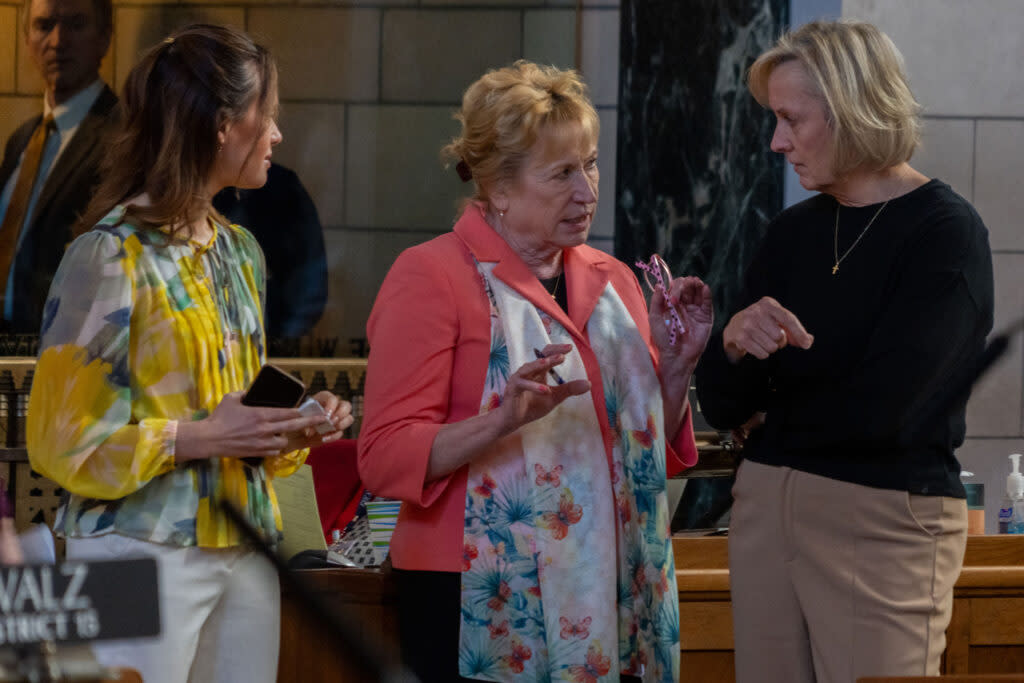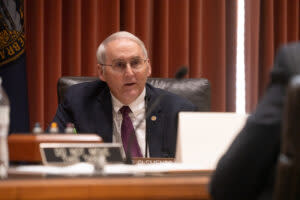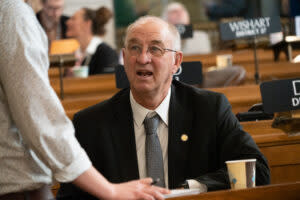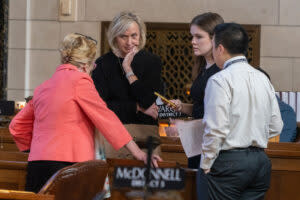Legislative leaders optimistic about Nebraska’s fiscal health after careful spending

- Oops!Something went wrong.Please try again later.
- Oops!Something went wrong.Please try again later.
- Oops!Something went wrong.Please try again later.
State Sen. Lou Ann Linehan of Elkhorn, center, talks with State Sens. Lynne Walz of Fremont (right) and Anna Wishart of Lincoln. April 9, 2024. (Zach Wendling/Nebraska Examiner)
LINCOLN — Top Nebraska state senators say they feel comfortable with the level of state reserves they left behind in 2024 and beyond after carefully considering spending requests during this year’s legislative session.
Nebraska lawmakers are constitutionally required to have a balanced budget and are projected to end the next fiscal year, on June 30, 2025, with more than $500 million in the state’s minimum reserves, or 4.5%, above the desired reserves goal. The state is projected in the following biennium to end about $50 million under that reserve goal
These figures could change when actual revenues come in this summer. They also don’t account for any special sessions, such as one anticipated in late July on property taxes.
Positive economic horizons
State Sen. Robert Clements of Elmwood, who chairs the Legislature’s Appropriations Committee, said the $50 million shortfall by June 30, 2027, is an “acceptable number” and remains in an adequate range.
State Sen. Robert Clements of Elmwood. Oct. 27, 2023. (Zach Wendling/Nebraska Examiner)
He noted that just days before the Legislature adjourned on April 18, projections were that spending would draw state funds down by more than $1 billion under that minimum reserve goal. As a result, lawmakers worked to bring down their fiscal requests.
“If it was $100 million, we probably would have to make some adjustments,” Clements said.
State Sen. Lou Ann Linehan of Elkhorn, who chairs the Legislature’s Revenue Committee, said economic forecasts are too conservative, so the state could be in a better position than estimates show. She said she also doesn’t see state revenues declining or remaining flat.
Linehan and Clements said that there is no recession and that Nebraska’s fiscal health is secure.
Every year, lawmakers bring bills asking for “more than we can possibly do,” Linehan said. Those requests are calculated daily on what is referred to as the “green sheet.”
Lowering fiscal requests
State Sen. Myron Dorn of Adams was one senator who regularly spoke about the estimated tally of requested funding, bringing attention to the need to keep about 16% of state revenues in the cash reserves, which he said is about $880 million.
State Sen. Myron Dorn of Adams. Jan. 5, 2023. (Zach Wendling/Nebraska News Service)
Lawmakers didn’t need to end the year at a wash with the desired minimum reserve amount, Dorn noted. But had it been something closer to $500 million, it could likely be a problem for future challenges when the Appropriations Committee assembles the next two-year budget.
“It didn’t seem like people were really aware,” Dorn said.
During one day of debate on a tax credit proposal, Dorn bluntly said lawmakers didn’t need to fight about what to fund. Rather, they needed to find out whether funding was available.
“This bill won’t go nowhere unless you come back and bring us some funding sources back,” he said at the time.
Lawmakers did precisely that under the guidance of Speaker John Arch of La Vista and committee chairs, Clements said, stating bill introducers brought many proposals down to the “minimum number” they could work with.
“I was very pleased at how hard people worked to do that,” Clements said.
The need for negotiation
Linehan was one such lawmaker who, in her quest to secure funding for Nebraska students to attend private K-12 schools rather than public counterparts, reduced her annual request by $15 million.
State Sen. Lou Ann Linehan of Elkhorn, center, talks with State Sens. Fred Meyer of St. Paul and Danielle Conrad of Lincoln. Dec. 7, 2023. (Zach Wendling/Nebraska Examiner)
She brought Legislative Bill 1402 as an alternative that would repeal last year’s measure — which had an annual price tag of $25 million and could have later ballooned to $100 million — and replaced the funding as a direct appropriation to the state treasurer rather than tax credits.
Linehan lowered LB 1402’s cost to $10 million annually as well with no “escalator clause,” or annual growth that would come outside legislative action.
“I knew what the green sheet said. I knew that there were some people concerned about the money. And I knew I had to get to 33,” Linehan said, referring to the number of votes she needed. “So you negotiate.”
Attracting out-of-state workers
Four other lawmakers — State Sens. Beau Ballard of Lincoln, John Fredrickson of Omaha, Teresa Ibach of Sumner and Lynne Walz of Fremont — joined Linehan in a host of lawmakers who similarly needed to adjust for their proposals to achieve passage this year.
Ballard’s proposal, LB 1400, created the Relocation Incentive Act at Gov. Jim Pillen’s request, establishing incentives for businesses to attract out-of-state workers. This includes relocation expenses for employees making between $70,000 and $250,000, up to 50% of such expenses with a maximum of $5,000 in credits allowed per employee.
State Sen. Beau Ballard of Lincoln, center, speaks with State Sen. Robert Dover of Norfolk. Dec. 7, 2023. (Zach Wendling/Nebraska Examiner)
The proposal was amended into LB 1023 and had an original estimated cost of about $8 million in its first year and $27 million the next. Lawmakers capped the program at $5 million per year.
“I mean, I was fine with the fiscal note because that means people are coming to the state,” Ballard said. “I think $5 million is a good starting point.”
The state must find a way to attract individuals to Nebraska, Ballard said, especially to grow the state’s tax base for property tax relief, so he looked at “pro business, pro economy” approaches. This resulted in the new “innovative” pilot program that will begin Jan. 1.
“It’s an immediate ROI (return on investment),” Ballard said.
Child care proposal loses funding
But not all lawmakers with a high fiscal note were as lucky. Fredrickson sought a multiplying effect to bring in more child care workers through his priority bill, LB 856.
State Sen. John Fredrickson of Omaha testifies before the Health and Human Services Committee. Sept. 20, 2023. (Zach Wendling/Nebraska Examiner)
Like Ballard, Fredrickson added a cap to the bill — $10 million annually — but he said it became “more and more clear” that lawmakers had limited funds. And despite his colleagues articulating that workforce and child care were top priorities, the Omaha senator said, they “did not have the political will” to make significant investments through his bill.
“We can talk the talk but we have got to walk the walk as well,” Fredrickson said.
Fredrickson dropped all state funding, instead making a technical change to a Nebraska Department of Health and Human Services rule that prohibited home child care providers from receiving free child care assistance for their own children if no other accommodations were available.
Such workers were otherwise eligible for the federal subsidy, Fredrickson said, and the change will support providers in particularly rural areas or parts of the state where child care is limited.
Fredrickson said he’ll continue working on his bill in the interim and will bring back funding legislation. He is confident he and his colleagues can reach an agreement, with Pillen’s support.
Plethora of education proposals
Ibach and Walz took a different approach, finding existing cash reserves that could fund their proposals.
Walz, in her final year as a lawmaker, took a hard look at her priority bill, a package of education bills in LB 1284, which had an estimated cost of $20.8 million.
State Sen. Lynne Walz of Fremont, center left, meets with State Sen. Lou Ann Linehan of Elkhorn, left, and their respective legislative aides, Amanda Callaway and Ryan Yang, on the floor of the Legislature. April 9, 2024. (Zach Wendling/Nebraska Examiner)
Along with other lawmakers who had bills in her package — Linehan and State Sens. George Dungan and Danielle Conrad, both of Lincoln — she looked at what could be reduced and what stakeholders could live with because “everybody deserves the opportunity to a good education.”
“This bill is just so important to education that I didn’t want to take the chance of having to fight for the funds on the floor,” Walz said.
She found a home in the Education Future Fund, which was created in last year’s legislative session through an initial $1 billion investment and $250 million every year after.
As passed, LB 1284 will cost about $4.1 million in its first year and $3.8 million in the second, nearly all from the Education Future Fund. About $150,000 in the first year and $80,000 in the second are for administrative costs.
Included in the bill are proposals to:
Establish a Computer Science and Technology Education Fund that will train teachers and support students to complete a graduation requirement in those areas (from Walz).
Train teachers in kindergarten through third grade how to teach reading through reading improvement mentorship programs and regional coaches (from Linehan).
Create a Dyslexia Research Grant Program to support Nebraska companies researching artificial-intelligence-based writing for individuals with dyslexia (from Linehan).
Expand eligibility for Nebraska Career Scholarships to include special education (from Dungan).
Distribute menstrual products to select schools in a pilot program, beginning in 2025 (from Conrad).
Incentivizing the fight again nitrates
Ibach’s priority bill, the Nitrogen Reduction Incentive Act in LB 1368, will encourage Nebraska farmers to adopt efficient and sustainable practices that will protect the state’s natural resources, such as from nitrates, and promote competition among farmers.
State Sen. Teresa Ibach of Sumner. March 3, 2023. (Zach Wendling/Nebraska News Service)
Under Ibach’s bill, the Nebraska Department of Natural Resources will establish a grant program for an annual per-acre incentive of at least $10.
Farmers must verify that they have reduced their commercial fertilizer use by the lesser of 40 pounds per acre for nitrogen or 15% by incorporating a qualifying product in the farmer’s nutrient plans.
The act includes a $5 million cap but includes a provision that the state will fund however much lawmakers make available, which in the first year will consist of at least $1 million from interest accrued in the state’s Water Resources Cash Fund, though Ibach said she and department officials will continue to look for other funds.
“Any private, public or grant opportunity I can find, I will tap into it,” Ibach said.
Ibach said it’s important to be fiscally responsible, and when faced with the risk of no funding, she looked elsewhere and met with Tom Reilly, director of the Department of Natural Resources.
“I was not going to settle for not putting the program in place because I think it’s that important to our producers, that important to our environment and that important to our state to be the first and fastest to find solutions to the nitrate issue that all Nebraskans think is an issue,” Ibach said.
She said it’s part of lawmakers’ jobs to be solutions driven, creative and find different funding mechanisms on behalf of Nebraskans.
“When you partner with really out-of-the-box thinking folks, you come up with solutions,” Ibach said. “I think that’s what we do every day.”
The post Legislative leaders optimistic about Nebraska’s fiscal health after careful spending appeared first on Nebraska Examiner.








